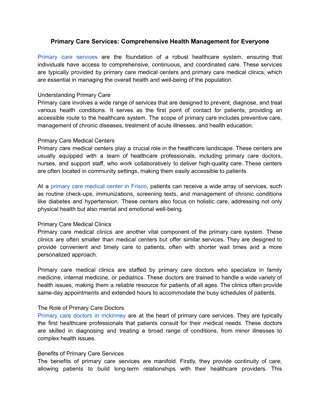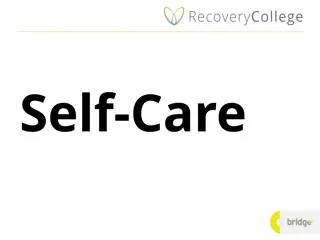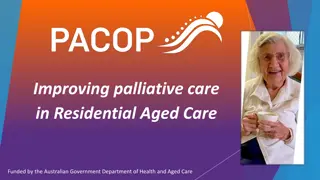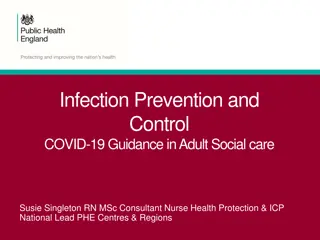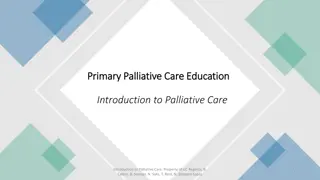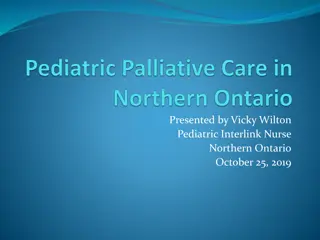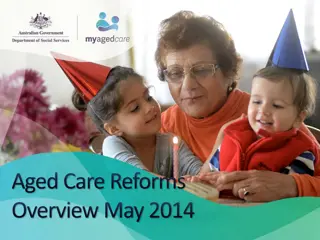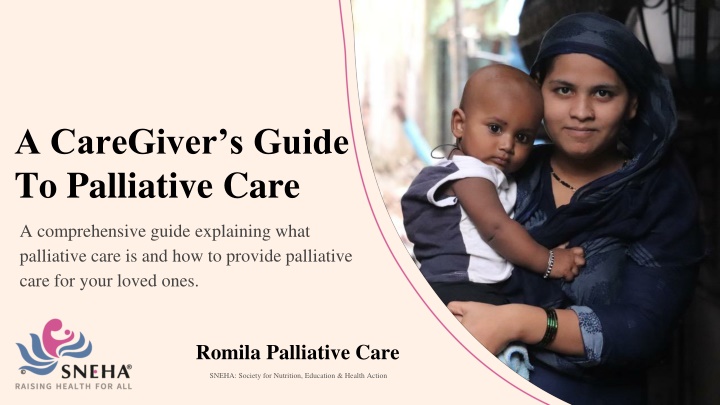
Comprehensive Guide to Palliative Care for Caregivers: Understanding, Providing, and Improving Quality of Life
Discover what palliative care entails, who needs it, how to access it, and why it's essential for improving the quality of life for patients with life-limiting illnesses. Learn about common misconceptions, the multidisciplinary approach to care, and ways to reduce caregiver burden effectively.
Download Presentation

Please find below an Image/Link to download the presentation.
The content on the website is provided AS IS for your information and personal use only. It may not be sold, licensed, or shared on other websites without obtaining consent from the author. If you encounter any issues during the download, it is possible that the publisher has removed the file from their server.
You are allowed to download the files provided on this website for personal or commercial use, subject to the condition that they are used lawfully. All files are the property of their respective owners.
The content on the website is provided AS IS for your information and personal use only. It may not be sold, licensed, or shared on other websites without obtaining consent from the author.
E N D
Presentation Transcript
A CareGivers Guide To Palliative Care A comprehensive guide explaining what palliative care is and how to provide palliative care for your loved ones. Romila Palliative Care SNEHA: Society for Nutrition, Education & Health Action
WHAT IS PALLIATIVE CARE? Palliative care aims to improve the quality of life of a patient facing a life limiting illness and their family. Common Misconceptions MYTH Palliative care is only for the elderly. Palliative care is only for cancer patients. Palliative care means that the doctor gives up on medical treatment. Palliative care is expensive. FACT Palliative care is not age restrictive. Palliative care is applicable to individuals facing any life limiting illness. Doctors begin treatment from diagnosis and continue to improve the quality of life for patients. Palliative care can be cost-effective and can reduce healthcare expenses.
WHO NEEDS PALLIATIVE CARE? Palliative care is required for people with a wide range of life-limiting illnesses. These are some of the most common illnesses that require palliative care in accordance with their incidence. The section, other includes chronic liver disease, multiple sclerosis, Parkinson s disease, rheumatoid arthritis, neurological disease, dementia, congenital anomalies, and drug-resistant tuberculosis. In the future, the need for palliative care will increase due a growing aging population and rising burden of noncommunicable diseases and some communicable diseases.
HOW TO GET PALLIATIVE CARE? As a caregiver, you can choose to provide palliative care at-home or outsource care at a palliative care centre or use a combination of at-home and palliative care centre resources HOW DOES PALLIATIVE CARE IMPROVE THE QUALITY OF LIFE It aims to improve the quality of life of a patient with an emphasis on dignity, respect, and the wishes of the person who is ill. Generally, a multidisciplinary . team provides care. This may include a physician, nurse physiotherapist, counsellor, dietician, and social worker. A care plan is formulated for each patient with the intention of symptom control and total pain (physical and psychosocial) control.
WHY USE PALLIATIVE CARE ? Caregiver burden is physical, emotional and mental exhaustion that occurs when taking care of someone else. Studies report that caregivers exhibit higher levels of stress and depression, lower subjective well-being, and worse physical health than non-caregivers. Nonetheless, caregivers have an essential role in the palliative care of loved ones. Caregiver burden can be reduced through a combination of caregiver care and outsourced care. Care Center Caregiver Care
PALLIATIVE CARE NEEDS Palliative care is unique for each individual and depends on a person s needs, preferences, and choices. In general, a patient s palliative care needs can be divided into 4 categories. Physical Comfort Practical Tasks Palliative Care Needs Mental and Emotional Needs Spiritual Needs
PALLIATIVE CARE AT HOME Physical Comfort Physical discomfort can come from a variety of sources. The following are the most common sources of discomfort. Pain Anorexia Breathlessness Constipation Depression Fatigue Vomiting Sleep Disturbance Diarrhea Anxiety Pain: Palliative care focuses on relieving pain without the side effects of drug dependence and/or abuse. Fatigue: Many people feel tired and have little energy. Alterations should be made to make everyday tasks easier. Some ways to reduce fatigue are: Having A Bedside Commode Having Baths With A Sponge Having A Shower Stool Consuming Protein Powder
PALLIATIVE CARE AT HOME Mental and Emotional Needs Many palliative care patients get depressed and anxious. The following are methods to create a more positive perspective. Physical Contact Be Present Communicate Comforting Mood Gestures of reassurance are good contact, like hand holding Talk about needs, wants, expectations Visit the patient, talk to the patient, read, play a game together Create a stress-free environment, play soft and calming music
PALLIATIVE CARE AT HOME Spiritual Needs Spiritual needs are very personal. Some people find peace and solace at the end of their lives through faith. Patients may want to connect with religious clergy or resolve unsettled issues. Practical Tasks There any many administrative tasks that become the responsibility of the caregiver. Some are: medical administration, symptom reporting, decision making, and doctor-patient connection. It is important to ensure that the caregiver is honest with the patient in their care. The patient should be able to voice their opinion and contribute to decisions regarding their care. Additionally, it is important to keep children informed of family members health prognosis.
PALLIATIVE CARE IN INDIA There are 908 palliative care centers in India, of which 841 centers are found in Kerala. On the whole, there is a shortage of palliative care in India, it is only accessible to 1%of the population. Some Palliative Care Resources: - Indian Association of Palliative Care: The national forum to connect, support and motivate individuals and institutions involved in palliative care. Website: https://www.palliativecare.in - Jascap: Has a list of Palliative Care centers in India. The address and contact details for each center is given. Website: https://jascap.org/palliative-care-centres-in-india/ - Caregiver Saathi: Provides guidance to caregivers through educational content, access to a community, support groups, and professional home-care services. Website: https://caregiversaathi.co.in/about-us - Pallium India: In-patient services are provided at the Trivandrum Institute of Palliative Sciences and delivered by a multidisciplinary team. Provides at-home palliative care services. - List of Organizations- -extension://efaidnbmnnnibpcajpcglclefindmkaj/https://www.snehamumbai.org/wp- content/uploads/2021/06/List-of-Organisations-Hospitals-and-Private-Practitioners-working-on-Palliative-Care.pdf




